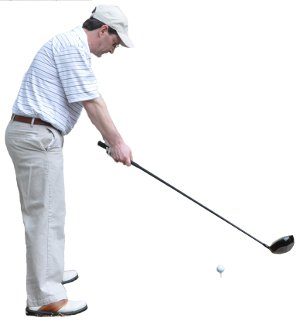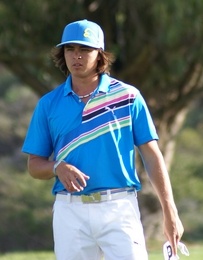 Wearing brightly colored outfits with shaggy hair and a deep California tan, Rickie Fowler is hard to miss on the golf course. He's easy to spot on the leaderboard, too – just look near the top.
Wearing brightly colored outfits with shaggy hair and a deep California tan, Rickie Fowler is hard to miss on the golf course. He's easy to spot on the leaderboard, too – just look near the top.
Fowler, a phenom out of Oklahoma State, is a shining young star on the PGA Tour. He was Rookie of the Year in 2010 and played even better in 2011, notching seven top-10 finishes and more than $2.8 million in earnings. By age 23, he'd already earned spots on United States Ryder Cup and Presidents Cup squads.
While Fowler cuts an eye-catching figure, his swing is a blink-and-you'll-miss it blur. Only in slow motion or still photos – like those of our stand-in -- can you see how unusual it is.
Unconventional move: At the start of the swing, Fowler's clubhead traces a path well outside the target line, and severely “off plane.”
|
|
|
|
Photo 1: Fowler utilizes the standard “one-piece takeaway,” with the arms and shoulders united in pulling the club back. His forearms and hands, however, barely rotate, causing a clubface that's closed relative to the target line. |
Photo 2: Even later in the backswing, Fowler's forearms still haven't rotated in earnest. This puts the clubhead well outside the hands in a position that's nowhere near the plane of the left arm. From here, Fowler must make a major correction to reach the top in good position. (The article explains how he does it.) |
Why it's a problem for amateurs: Try swinging this way without hitting a huge hook and you'll understand. With a clubface this closed, this far into the backswing, you're virtually assured of being “shut” at the top – and the bottom, i.e. impact.
How Fowler gets away with it: About halfway to the top, Fowler sharply turns those forearms to get the shaft in line with his arms and shoulders. Voila – he's on plane. This requires exceptional timing and a lifetime of doing it the same way, over and over and over. It helps that Fowler's slight build (5'9”, 150 pounds) hides a heck of an athlete.
The cure: Under-rotation of the forearms is a fairly common swing fault. The cure is simple, but takes practice to ingrain.
First, check the position of your clubhead when the hands reach hip height on the backswing. If it points in front of you, the clubface is closed. You want it pointing straight up (or nearly straight up). Work on getting to this position by slowly rolling the forearms -- rather than steering the clubhead with the hands and wrists – as the shoulders turn away from the ball. Note that if the clubface points behind you (open), the forearms have over-rotated a touch.
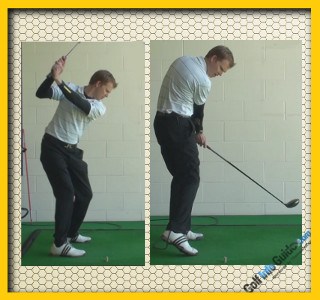
Rickie Fowler Off-Plane Takeaway
Rickie Fowler, for many reasons, is one of the most-popular young players in the game of golf today. Fowler has essentially everything required to make a star in the sporting world – he is extremely talented, offers plenty of personality, engages with the fans, and takes pride in his work. With a unique style that stands out on the golf course, and a back story that is different from most of his peers, Fowler will likely be among the fan favorites for many years to come.
Of course, all of that appeal is basically useless without the ability to win golf tournaments. Fortunately, Fowler has that too. While he does not yet own a major title, Fowler has fared extremely well in each of the four majors, and he also won the 2015 Players Championship. At just 27 years of age, there is little doubt that Fowler will add a number of big titles to his trophy case – perhaps even a major championship.
One of the reasons that Fowler has been able to obtain success in recent years is the changes that he has made to his swing with the help of noted teacher Butch Harmon. Fowler's swing looks dramatically different than it did when it first came onto the scene, and it has allowed him to become more consistent and reliable under pressure. The refined swing is simpler and easier to repeat, meaning Fowler is able to hit the same shot time and time again, something that is required for a top professional golfer.
This article, however, is going to look closely at Fowler's previous swing, one that also made him quite successful. Despite having its own unique characteristics or quirks, that swing was able to take Fowler to the top of the amateur game, and it is what allowed him to reach the professional tour in the first place. Although he may not have ever had his recent success without those swing changes, it should not be forgotten that his first swing worked pretty nicely in its own right.
In his old swing, Rickie Fowler had a rather unique takeaway, one that a golf teacher would consider 'off-plane'. This takeaway kept the club head well to the outside of his hands, leading to an incredibly laid-off position at the top of the backswing. While Fowler obviously was able to make this move work quite nicely in his game for many years, he also struggled with some periods of inconsistency due to the impressive timing required to pull off quality shots from that laid-off position. If his timing was off even slightly, Fowler would lose the ability to control the ball at a high level. The content below will take a closer look at that takeaway, and what you can learn from the adjustments that Fowler has made to his swing in recent years.
All of the instruction contained below is based on a right handed golfer. If you happen to play left handed, please reverse the directions as necessary.
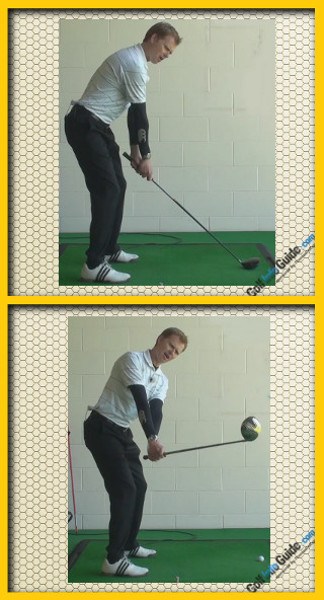
Changing Planes
The ability to change planes during the golf swing is something that very few players have – and even fewer still are able to execute that move to the level of someone like Rickie Fowler. Generally speaking, when players arrive on the PGA Tour, they already have a swing that is largely polished and free from any major mechanical issues. That is because it is so difficult to get to the Tour in the first place, that only players with great swings are able to make it.
That isn't to say that the old version of Fowler's swing wasn't great, it was just unique. Most players lack the athletic ability to get the club back into a good position to strike the ball after making such an off-plane takeaway. Usually, when the takeaway gets off track, the player never recovers and a poor shot is the result. Thanks to the tremendous natural talent and hand-eye coordination possessed by Fowler, he was able to recover his swing and still hit great shots despite his unique takeaway. Of course, if you have a problem in your own takeaway, you may not have the skills needed to make the right adjustments in the middle of your swing.
In his old swing, Rickie Fowler would take the club well to the outside of a traditional backswing plane, keeping the club head far outside the position of his hands when the club was parallel to the ground. That meant that he would get to the top of the backswing in a dramatically laid-off position, and he would have to re-route the club quickly in order to hit a good shot. He was able to do this, of course, more times than not, and he rose to become one of the top young players in the game even with this unique element to his technique.
Even though Fowler no longer swings the club in this manner, you can still learn plenty about your own game from watching his old swing. How does your current takeaway compare to the move that he used to use? Are you keeping your hands way to the inside of the club head during the takeaway, or are you finding a good plane successfully with little effort? Take a quick video of your swing on the driving range and check out your takeaway path for yourself. If you find that you are off-plane as Fowler used to be, take some time to work on the fundamentals of your takeaway until you get straightened out. Specifically, try to turn your shoulders on a flatter plane to enable a rotation of the club, which will get it closer to the right plane so you can be set up for a simple and aggressive downswing.
One of the problems with watching highly skilled players like Rickie Fowler is that the average golfer begins to believe that they can get away with major mechanical mistakes in their swing as well. After all, if Fowler could become the number one ranked amateur golfer in the world using this takeaway, couldn't you play good golf with a faulty takeaway as well? Maybe, maybe not. It is important to remember the incredible level of skill and talent that is possessed by Fowler and other professionals, which allows them to gloss over technical errors in their swing technique. Thanks to tremendous hands and natural athletic ability, Rickie Fowler became a great player despite what most would consider a faulty swing pattern. With that pattern changed, he is now even a better player, and is truly one of the top golfers in the world.
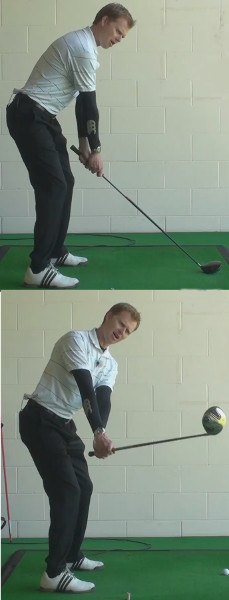
The Slow Part of the Swing
The takeaway is a crucial part of the golf swing because it is one of the only points during the swing where the club is moving slowly. There is no excuse to get your takeaway wrong on any shot during your round because the club isn't moving fast enough to throw you off line. Later in the swing, as the club is accelerating into the ball, it is easier to make mistakes – and those mistakes are justifiable. The only reason to make a mistake in your takeaway is a lack of practice, so get out to the range and work on your technique until the takeaway become natural time after time.
By the time the swing reaches the transition phase, most golfers will be unable to make any significant adjustments to the path of the club the rest of the way down to impact. This is again what makes Rickie Fowler so unique. He was able to slot the club into just the right spot on the way down, despite being laid-off at the top of the swing (meaning the club shaft was pointing to the left of the intended target). You shouldn't expect yourself to have that same kind of ability. Fowler is a player with rare talent, but for the rest of us, using a conventional takeaway that puts the club in the right spots is the best way to go. If you can start your swing with a takeaway that is perfectly on plane, you will stand a far better chance of producing a quality swing in the end.
To work on your own backswing, the best thing to do is take some time away from the golf course or driving range where you can just rehearse the takeaway phase of the swing over and over again. Without the rest of your swing to worry about, and without the results of an actual shot to be concerned with, you can focus in simply on executing a great takeaway time and time again. While the takeaway should be one of the easiest parts of the swing since the club is moving slowly, that doesn't mean you can ignore it when it comes to practice. Set aside a few minutes on occasion to work on the fundamentals of your takeaway and you will notice that your swing as a whole soon improves.
If you do decide to complete some basic takeaway practice sessions, focus on the three fundamentals below.
- Quiet head position. One of the worst things you can do at the start of your swing is to move your head excessively from side to side or up and down. Your head should be still and quiet at the start of the swing, and it should remain that way mostly through the rest of your swing. While a little bit of head movement is acceptable in the downswing, you never want to have your head position moving dramatically at any point during the golf swing action. Keep your eyes focus on the back of the ball as you start the swing, and you will have a much easier time keeping your head still and the rest of your body in position.
- Soft right hand. Another major takeaway problem that is seen in the games of amateur golfers is an overactive right hand during the takeaway phase of the swing. When the right hand does too much of the work in the first foot or so of your swing, you will whip the club quickly to the inside and you will be 'across the line' at the top. This is actually the opposite problem to the takeaway tendency that Rickie Fowler had earlier in his career. His hands did almost nothing in the takeaway at that point, but many amateur players are too active with the hands (specifically the right hand) when the swing is just getting started. Keep your hands quiet early in the takeaway and make sure you are getting a good rotation from your shoulders in order to turn the club away from the target.
- Slow to start. Moving the club too quickly immediately away from the ball is a common cause of trouble in the golf swing. There is only one point during the swing when the club needs to be moving quickly – and that is when it is coming down through impact to actually strike the shot. Other than that, you can take your time to build up momentum gradually as you swing the club back and through. Get your swing off to a smooth start by moving the club slowly back away from the ball, gaining speed a little bit at a time along the way. It is tempting to rush when you stand over the ball hoping to launch a long drive high into the air, but taking your time will lead to far better results.
While Rickie Fowler may have had a unique takeaway earlier in his career, he always had the kind of wonderful tempo that you would expect from an accomplished player. As you are working on your own tempo, make sure that you are constantly focused on how you can improve the rhythm of your swing, along with the physical positions. Plenty of golfers get fixated on the positions of the club, rather than the rhythm of their swing, and they are never able to produce great results on the course when it counts.

Simple, Simple, Simple
It is easy to get caught up in all of the complicated swing theory that you can use when trying to put together the perfect mechanical motion. While there is nothing wrong with working on your swing technique, you also want to give your mind a chance to be clear as you stand over the ball so that your natural athletic ability can shine through. This is something that Rickie Fowler does particularly well. His swing flows nicely, and you can see how athletic he is just from watching a shot or two on the driving range. If you are standing over the ball with five different mechanical thoughts running through your head, there is no way you will ever be happy with the quality of your game.
One of the overall goals that you should have in your golf swing is to keep the swing as simple as possible from start to finish. The fewer moving parts that you have in your swing, the less chance your swing will get off track at some point along the way. Also, simple swings tend to hold up far better under pressure, so simplicity is a great thing if you plan on competing in any tournaments. It is one thing to play good golf when nobody is watching – it is another thing altogether to play well when the heat is on.
Many golfers feel like a simple swing will equal a weak swing, so they try to add motion to their technique in order to gain power. In reality, the opposite tends to be true. By keeping your swing simple, you should be able to hold your balance nicely and turn aggressively through the ball. An aggressive turn and great balance are crucial when it comes to developing power, so you will likely find that your simple golf swing turns out to be the one that sends the ball flying the farthest down the fairway.
A simple golf swing gets started with a simple takeaway. Your move away from the ball shouldn't have an excess of motion or anything else that isn't absolutely necessary – it should be a simple turn away from the ball with your shoulders, while your lower body holds steady and your arms go along for the ride. If you look at the takeaway that Rickie Fowler uses now to start his swing, you will see this kind of simplicity reflected perfectly. Also, you will see that most of the professionals on the Tour today use a simple and quiet takeaway, which should be a sure indication of how effective this model can be.

Be Yourself
Although Rickie Fowler has changed his swing in order to reach new heights in the game, there is something to be said for being yourself on the course and sticking with a technique that feels natural to you (and leads to success). You shouldn't feel pressured to change your swing technique in order to make your move look like the swing that everyone else on the course is making. Rickie Fowler didn't change his swing to make it look good – he made those changes to make the swing more effective, so he could battle the best players in the world on a regular basis.
Every time you decide to make some form of change in your swing, make sure you are doing it with the goal of hitting better, more consistent shots. It should have nothing to do with the aesthetic element of your swinging motion. Did Rickie Fowler's old takeaway, and the rest of his swing, look a little 'funny'? Sure, many people probably thought they did. However, was anyone laughing when he was racking up amateur titles and making his way onto the Tour at a young age? Doubtful. It doesn't matter one bit what your swing looks like, or what other people think of it – the only thing that matters in golf is how long it takes you to get the ball into the hole.
You should take this individualistic approach to every part of your game, from your swing to the equipment you use and even the clothes that you wear. Rickie Fowler is well-known in the golf world for wearing some 'unique' outfits, that probably wouldn't be worn by a number of his contemporaries on the Tour. However, that is what makes Rickie himself, and that is what has made him such a fan favorite in his young career. You don't need to use a specific driver just because it is popular, and you don't have to wear a boring shirt and tan slacks if you would rather have more style and color in your wardrobe. In the end, golf should be all about fun, and it would be a better game as a whole if it had more people like Rickie Fowler walking the fairways.
There is one other thing that you will likely enjoy about being yourself on the course – you will play better. It is tempting to copy other players who you see having success in the game, because you think replicating their technique is the quickest path to lower scores. It rarely works out that way, however. More often, players who copy the technique of other golfers are left confused and frustrated, wondering why their game has gone downhill so quickly. Stick to what it is that comes naturally to you, and your scores should gradually come down as you get better and better at executing your shots on the course.
Rickie Fowler used to have a takeaway that was rather off-plane, yet he was still able to play some great golf. Now that his swing takes a more traditional path, he is even more consistent, and his results have only improved. With many great years ahead of him and a beautiful golf swing to go along with his personality and passion for the game, it won't be any surprise to see Fowler contending for the biggest titles in the sport.


